Monitoring Intertidal Habitats for Effects from Biosolids Applications onto an Adjacent Forestry Plantation
Abstract
1. Introduction
2. Materials and Methods
2.1. Study Area
2.2. Biosolids Application on Moturoa/Rabbit Island
2.3. Coastal Monitoring Programme
- Qualitative surveys of substratum type, topography, and major biological habitats along transects perpendicular to the shoreline at six-month intervals for the first five years (1996–2001) of the application programme;
- Quantitative transect surveys of benthic microalgal and macroalgal cover (in 1996, prior to application, and in 2003, 2008, 2014, and 2019);
- Quantitative transect surveys of epifaunal organisms and burrows, infauna community composition (from 2008), visual assessment of the sediment profile (colour, depth of apparent redox discontinuity), sediment grain size, organic matter and nutrient content, and trace metal and bacteriological contamination along the foreshore (in 1996, prior to biosolids application (nutrients and organic matter only), and in 2003, 2008, 2014, and 2019).
2.3.1. Sampling Sites
2.3.2. Field Observations
- Shoreline topography (description of surface features within the general transect vicinity, e.g., oyster reefs, macroalgal beds, tidal channels);
- Sediment type (mud, sand, shell, etc.);
- Abundance of conspicuous epifauna on five replicates 0.1 m2 quadrats (e.g., crab holes, shellfish, and other macroinvertebrate species);
- Macroalgal species and percent coverage: Where a high level of macroalgal cover existed, the percent coverage of the sediment habitat was estimated using five replicates of a randomly placed 0.25 m2 quadrat containing gridlines, dividing it into 36 equally spaced squares. The number of grid intersections (including the outer frame) that overlapped vegetation were counted and the result converted to percent (i.e., number × 2 = %);
- Sediment profiles (62 mm-diameter, 100 mm-depth cores extruded and described according to the stratification of colour and composition and any corresponding indications of sediment anoxia);
2.3.3. Sediment, Infauna, and Shellfish Sampling
2.3.4. Laboratory Analyses
2.4. Data Analyses
3. Results
3.1. Shoreline Observations
3.2. Sediment Composition, Nitrogen and Contaminant Concentrations, and Benthic Communities
3.2.1. Sediment Composition
3.2.2. Organic Matter and Nitrogen
3.2.3. Trace Metals/Arsenic
3.2.4. Faecal Indicator Bacteria
3.2.5. Benthic Infauna Communities
3.3. Relationship between Biosolids Application and Nitrogen Concentrations: 2018–2019
4. Discussion
5. Conclusions and Future Perspectives
Supplementary Materials
Author Contributions
Funding
Data Availability Statement
Acknowledgments
Conflicts of Interest
References
- Gianico, A.; Braguglia, C.M.; Gallipoli, A.; Montecchio, D.; Mininni, G. Land application of biosolids in Europe: Possibilities, con-straints, and future perspectives. Water 2021, 13, 102. [Google Scholar] [CrossRef]
- Magesan, G.N.; Wang, H. Application of municipal and industrial residuals in New Zealand forests: An overview. Aus. J. Soil Res. 2003, 41, 557–569. [Google Scholar] [CrossRef]
- Bai, J.; Sun, X.; Xu, C.; Ma, X.; Huang, Y.; Fan, Z.; Cao, X. Effects of sewage sludge application on plant growth and soil characteristics at a Pinus sylvestris var. mongolica plantation in Horqin sandy land. Forests 2022, 13, 984. [Google Scholar]
- National Resource Council. Biosolids Applied to Land: Advancing Standards and Practices; The National Academies Press: Washington, DC, USA, 2002.
- Gerba, C.P.; Pepper, I.L. Wastewater treatment and biosolids reuse. In Environmental Microbiology, 2nd ed.; Academic Press Inc.: Cambridge, MA, USA, 2009; pp. 503–530. [Google Scholar]
- Atalay, A.; Bronick, C.; Pao, S.; Mersie, W.; Kalantari, A.; Mcnamee, C.; Whitehead, B. Nutrient and microbial dynamics in biosolids amended soils following rainfall simulation. Soil Sed. Contam. Int. J. 2007, 16, 209–219. [Google Scholar] [CrossRef]
- McLaren, R.G.; Black, A.; Clucas, L.M. Changes in Cu, Ni, and Zn availability following simulated conversion of biosolids-amended forest soils back to agricultural use. Aus. J. Soil. Res. 2010, 48, 286–293. [Google Scholar] [CrossRef]
- Xue, J.; Kimberley, M.O.; Ross, C.; Gielen, G.; Tremblay, L.A.; Champeau, O.; Horswell, J.; Wang, H. Ecological impacts of long-term application of biosolids to a radiata pine plantation. Sci. Total Environ. 2015, 530–531, 233–240. [Google Scholar] [CrossRef] [PubMed]
- Wang, M.; Xue, J.; Horswell, J.; Kimberley, M.O.; Huang, Z. Long-term biosolids application alters the composition of soil microbial groups and nutrient status in a pine plantation. Biol. Fert. Soils 2017, 53, 799–809. [Google Scholar] [CrossRef]
- NZWWA. Guidelines for the Safe Application of Biosolids to Land in New Zealand. Report to the New Zealand Water and Wastes Association and Ministry for the Environment. 2003. Available online: https://www.waterA/NZ.org.A/NZ/Folder?Action=View%20File&Folder_id=101&File=biosolids_guidelines.pdf (accessed on 5 May 2023).
- Magesan, G.N.; Wang, H.; Clinton, P. Best Management Practices for Applying Biosolids to Forest Plantations in New Zealand. SCION Report 45869. 2010. Available online: https://envirolink.govt.A/NZ/assets/Envirolink/742-TSDC53-Best-management-practices-for-applying-biosolids-to-forests.pdf (accessed on 5 May 2023).
- Ippolito, J.A.; Ducey, T.F.; Diaz, K.; Barbarik, K.A. Long-term biosolids land application influences soil health. Sci. Total Environ. 2021, 791, 148344. [Google Scholar] [CrossRef] [PubMed]
- Grey, M.; Henry, C. Phosphorus and nitrogen runoff from a forested watershed fertilized with biosolids. J. Environ. Qual. 2002, 31, 926–936. [Google Scholar] [CrossRef]
- Abreu-Junior, C.H.; de Oliveira, M.G.; Cardoso, P.H.S.; Mandu, T.d.S.; Florentino, A.L.; Oliveira, F.C.; dos Reis, J.V.; Alvares, C.H.; Stape, J.L.; Nogueira, T.A.R.; et al. Sewage sludge application in Eucalyptus urograndis plantation: Availability of phosphorus in soil and wood production. Front. Environ. Sci. 2020, 8, 116. [Google Scholar] [CrossRef]
- Da Silva, P.H.M.; Poggiani, F.; Laclau, J.P. Applying sewage sludge to Eucalyptus grandis plantations: Effects on biomass production and nutrient cycling through litterfall. Appl. Environ. Soil Sci. 2011, 2011, 710614. [Google Scholar] [CrossRef]
- Gutiérrez-Ginés, M.; Robinson, B.H.; Esperschuetz, J.; Madejón, E.; Horswell, J.; McLenaghen, R. Potential use of biosolids to reforest degraded areas with New Zealand native vegetation. J. Environ. Qual. 2017, 46, 906–914. [Google Scholar] [CrossRef] [PubMed]
- Nelson Regional Sewerage Business Unit. Wastewater Asset Management Plan. 2017. Available online: http://www.nrsbu.govt.nz/assets/NRSBU/Plans-and-reports/amp/Nelson-Regional-Sewerage-Business-Unit-Asset-Management-Plan-2017.pdf (accessed on 5 May 2023).
- Fryer, B. Model Based Study of Autothermal Thermophilic Aerobic Digestion (ATAD) Processes. Masters’ Thesis, Massey University, Palmerston North, New Zealand, 2000. [Google Scholar]
- Ballard, R. Use of fertilisers at establishment of exotic forest plantations in New Zealand. N. Z. J. For. Sci. 1978, 8, 70–104. [Google Scholar]
- Wilks, P.; Haddon, S. Tasman District Council Forest Management Plan for the period 2014/2019. PF Olsen Report FSCGS04. 2014. Available online: https://pfolsen.blob.core.windows.net/productionmedia/2198/tdc_mp14.pdf (accessed on 5 May 2023).
- Tonkin and Taylor. Moturoa/Rabbit Island Biosolids Reconsenting. Assessment of Effects on the Environment. Prepared for Nelson Regional Sewerage Business Unit by Tonkin & Taylor Ltd. 2020. Available online: https://www.tasman.govt.nz/document/serve/01A%20RM200638%20NRSBU%20-%20Application%20AEE%20-%20AEE%20Apps%20A%20to%20C.pdf?DocID=31414 (accessed on 5 May 2023).
- Davidson, R.J.; Moffat, C.R. A Report on the Ecology of Waimea Inlet, Nelson; Department of Conservation, Nelson/Marlborough Conservancy Occasional Publication: Nelson, New Zealand, 1990; No. 1. [Google Scholar]
- Robertson, B.M.; Gillespie, P.A.; Asher, R.A.; Frisk, S.; Keeley, N.B.; Hopkins, G.A.; Thompson, S.J.; Tuckey, B.J. Estuarine Environmental Assessment and Monitoring: A National Protocol. Part A. Development, Part B. Appendices, Part C. Application. 2002. Available online: https://docs.niwa.co.nz/library/public/EMP_part_c.pdf (accessed on 7 March 2023).
- Stevens, L.M.; Robertson, B.M. Nelson Region Estuaries: Vulnerability Assessment and Monitoring Recommendations; Wriggle Coastal Management for Nelson City Council: Nelson, New Zealand, 2017; 36p. Available online: https://www.nelson.govt.nz/assets/Environment/Downloads/Environmental-monitoring/estuarine-health/NCC-regional-estuarine-monitoring-and-reporting-WRIGGLE-vulnerability-assessment-2017.pdf (accessed on 7 August 2023).
- Hume, T.; Gerbeaux, P.; Hart, D.; Kettles, H.; Neale, D. A Classification of New Zealand’s Coastal Ecosystems. NIWA Client Report No. HAM2016-062 prepared for the Ministry for the Environment. 2016. Available online: https://ir.canterbury.ac.A/NZ/bitstream/handle/10092/15225/a-classification-of-A/NZ-coastal-hydrosystems.pdf?sequence=2 (accessed on 5 May 2023).
- Heath, R.A. Broad classification of New Zealand inlets with emphasis on residence times. N. Z. J. Mar. Freshw. Res. 1976, 10, 429–444. [Google Scholar] [CrossRef]
- Whitehead, A.L.; Booker, D.J. NZ River Maps: An Interactive Online Tool for Mapping Predicted Freshwater Variables across New Zealand. NIWA, Christchurch. 2020. Available online: https://shiny.niwa.co.nz/nzrivermaps/ (accessed on 5 May 2023).
- Stevens, L.M.; Scott-Simmonds, T.; Forrest, B.M. Broad Scale Intertidal Monitoring of Waimea Inlet; Salt Ecology Report 052; Tasman District and Nelson City Councils: Richmond, New Zealand, 2020; 50p.
- Tasman District Council. Tasman Resource Management Plan (TRMP). 2018. Available online: https://www.tasman.govt.A/NZ/my-council/key-documents/tasman-resource-management-plan/ (accessed on 5 May 2023).
- Wilks, P.; Wang, H. The Rabbit Island Biosolids Project. A/NZ J. For. 2009, 54, 33–36. [Google Scholar]
- Gillespie, P.; Asher, R. Estuarine Impacts of the Land Disposal of Sewage Sludge on Rabbit Island: 2003 Monitoring Survey; Cawthron Report No. 862; Nelson Regional Sewerage Business Unit: Nelson, New Zealand, 2004.
- Nelson City Council. State of the Environment Report. 2020. Available online: http://www.nelson.govt.A/NZ/council/plans-strategies-policies/strategies-plans-policies-reports-and-studies-a-z/state-of-the-environment-reports/ (accessed on 5 May 2023).
- Gillespie, P. Benthic and Planktonic Microalgae in Tasman Bay: Biomass Distribution, and Implications for Shellfish Growth; Motueka Integrated Catchment Management (Motueka ICM) Programme Report Series; Cawthron Report No. 835; Cawthron Institute: Nelson, New Zealand, 2003. [Google Scholar]
- Gillespie, P.A.; Maxwell, P.D.; Rhodes, L.L. Microphytobenthic communities of subtidal locations in New Zealand: Taxonomy, biomass, production, and food-web implications. N. Z. J. Mar. Freshw. Res. 2000, 34, 41–53. [Google Scholar] [CrossRef]
- FAO. Standard Operating Procedure for Soil Total Nitrogen—Dumas Dry Combustion Method. 2021. Available online: https://www.fao.org/3/cb3646en/cb3646en.pdf (accessed on 5 August 2023).
- D422-63; Standard Test Method for Particle-Size Analysis of Soils. ASTM: West Conshohocken, PA, USA, 2007. Available online: https://www.astm.org/d0422-63r07.html (accessed on 5 August 2023).
- APHA. 3125 Metals by Inductively Coupled Plasma-Mass Spectrometry. In Standard Methods for the Examination of Water and Wastewater, 24th ed.; Lipps, W.C., Baxter, T.E., Braun-Howland, E., Eds.; APHA: Washington, DC, USA, 2022; Available online: https://www.standardmethods.org/doi/10.2105/smww.2882.048 (accessed on 5 August 2023).
- APHA. Compendium of Methods for the Microbiological Examination of Foods, 5th ed.; Salfinger, Y., Tortorello, M.L., Eds.; APHA: Washington, DC, USA, 2015; Chapter 9.8; Available online: https://ajph.aphapublications.org/doi/abs/10.2105/MBEF.0222 (accessed on 5 October 2021).
- APHA. 9230 Fecal Enterococcus/Streptococcus Groups. In Standard Methods for the Examination of Water and Wastewater, 23rd ed.; APHA: Washington, DC, USA, 2018. [Google Scholar] [CrossRef]
- ANZG. Toxicant default guideline values for sediment quality. In Australian and New Zealand Guidelines for Fresh and Marine Water Quality; Australian and New Zealand Governments and Australian State and Territory Governments: Canberra ACT, Australia, 2018. Available online: https://www.waterquality.gov.au/anz-guidelines/guideline-values/default/sediment-quality-toxicants (accessed on 5 May 2023).
- Ministry for Primary Industries. Animal Products Notice: Regulated Control Scheme—Bivalve Molluscan Shellfish for Human Consumption. 2018. Available online: https://www.mpi.govt.A/NZ/dmsdocument/30282-animal-products-notice-regulated-control-scheme-bivalve-molluscan-shellfish-for-human-consumption-2018 (accessed on 5 May 2023).
- Pielou, E.C. Ecological Diversity; John Wiley & Sons: New York, NY, USA, 1975. [Google Scholar]
- Sturrock, K.; Rocha, J. A multidimensional scaling stress evaluation table. Field Methods 2000, 12, 49–60. [Google Scholar] [CrossRef]
- Clarke, K.R.; Gorley, R.N.; PRIMER v7: User Manual/Tutorial. PRIMER-E: Plymouth. 2015. Available online: http://updates.primer-e.com/primer7/manuals/User_manual_v7a.pdf (accessed on 5 May 2023).
- Stevens, L.M.; Robertson, B.M. Waimea Inlet 2010: Vulnerability Assessment and Monitoring Recommendations; Wriggle Coastal Management for Tasman District Council: Richmond, New Zealand, 2010; 58p.
- Keeley, N.B.; Macleod, C.K.; Forrest, B.M. Combining best professional judgement and quantile regression splines to improve characterisation of macrofaunal responses to enrichment. Ecol. Ind. 2012, 12, 154–166. [Google Scholar] [CrossRef]
- Tinholt, R. The Value of Biosolids in New Zealand—An Industry Assessment. Paper presented at the Water New Zealand Conference & Expo. 2019. Available online: https://www.waternz.org.nz/Attachment?Action=Download&Attachment_id=4029 (accessed on 5 May 2023).
- Tasman District Council. Moturoa/Rabbit Island Reserve Management Plan. Council Report RCN16-09-08. 2016. Available online: https://www.google.com/url?sa=i&rct=j&q=&esrc=s&source=web&cd=&cad=rja&uact=8&ved=0CAIQw7AJahcKEwiord-M1u__AhUAAAAAHQAAAAAQAg&url=https%3A%2F%2Fwww.tasman.govt.nz%2Fdocument%2Fserve%2FMoturoa-Rabbit%2520Island%2520Reserve%2520Management%2520Plan%25202016.pdf%3FDocID%3D29383&psig=AOvVaw0yBchehP7inUEhaGXEwRUs&ust=1688374886043243&opi=89978449 (accessed on 7 August 2023).
- Berthelsen, A.; Atalah, J.; Clark, D.; Goodwin, E.; Sinner, J.; Patterson, M. New Zealand estuary benthic health indicators summarised nationally and by estuary type. N. Z. J. Mar. Freshw. Res. 2019, 54, 24–44. [Google Scholar] [CrossRef]
- Robertson, B.M.; Stevens, L.; Robertson, B.; Zeldis, J.; Green, M.; Madarasz-Smith, A.; Plew, D.; Storey, R.; Oliver, M. A/NZ Estuary Trophic Index Screening Tool 2. Determining Monitoring Indicators and Assessing Estuary Trophic State; Prepared for Envirolink Tools Project: Estuarine Trophic Index, MBIE/NIWA Contract No: C01X1420; Wriggle Limited: Nelson, New Zealand, 2016. [Google Scholar]
- Robertson, B.; Robertson, B. Waimea Inlet Fine Scale Monitoring 2013/14. Wriggle Coastal Management Report Prepared for Tasman District Council. 2014. Available online: https://waimeainlet.wordpress.com/resource-documents/ (accessed on 5 May 2023).
- Forrest, B.M.; Gillespie, P.A.; Cornelisen, C.D.; Rogers, K.M. Multiple indicators reveal river plume influence on sediments and benthos in a New Zealand coastal embayment. N. Z. J. Mar. Freshw. Res. 2007, 41, 13–24. [Google Scholar] [CrossRef]
- Williamson, R.B.; Morrisey, D.J. Stormwater contamination of urban estuaries. 1. Predicting the build-up of heavy metals in sediments. Estuaries 2000, 23, 56–66. [Google Scholar] [CrossRef]
- Morrisey, D.; Webb, S. Coastal Effects of the Nelson (Bell Island) Regional Sewerage Discharge: Benthic Monitoring Survey 2016; Cawthron Report No. 2979; Nelson Regional Sewerage Business Unit: Nelson, New Zealand, 2017.
- Boehm, A.B. Enterococci concentrations in diverse coastal environments exhibit extreme variability. Environ. Sci. Technol. 2007, 41, 8227–8232. [Google Scholar] [CrossRef] [PubMed]
- MacDiarmid, A.; McKenzie, A.; Sturman, J.; Beaumont, J.; Mikaloff-Fletcher, S.; Dunne, J. Assessment of Anthropogenic Threats to New Zealand Marine Habitats; New Zealand Aquatic Environment and Biodiversity Report No 9; New Zealand Ministry of Agriculture and Forestry: Wellington, New Zealand, 2012; Volume 3, 255p.
- Lotze, H.K.; Lenihan, H.S.; Bourque, B.J.; Bradbury, R.H.; Cooke, R.G.; Kay, M.C.; Kidwell, S.M.; Kirby, M.X.; Peterson, C.H.; Jackson, J.B.C. Depletion, degradation, and recovery potential of estuaries and coastal seas. Science 2006, 312, 1806–1809. [Google Scholar] [CrossRef] [PubMed]
- Wang, H.; Brown, S.L.; Magesan, G.N.; Slade, A.H.; Quintern, M.; Clinton, P.W.; Payn, T.W. Technological options for the management of biosolids. Environ. Sci. Pollut. Res. 2008, 15, 308–317. [Google Scholar] [CrossRef] [PubMed]
- UN-HABITAT, Greater Moncton Sewerage Commission. Global Atlas of Excreta, Wastewater Sludge, and Biosolids Management: Moving Forward the Sustainable and Welcome Uses of a Global Resource; LeBlanc, R.J., Matthews, P., Richard, R.P., Eds.; United Nations Human Settlements Programme (UN-HABITAT): Nairobi, Kenya, 2008; Available online: https://unhabitat.org/global-atlas-of-excreta-wastewater-sludge-and-biosolids-management (accessed on 5 May 2023).
- Brown, S.; Ippolito, J.A.; Hundal, L.S.; Basta, N.T. Municipal biosolids—A resource for sustainable communities. Curr. Opin. Environ. Sci. Health 2020, 14, 56–62. [Google Scholar] [CrossRef]
- Sablayrolles, C.; Gabrielle, B.; Montrejaud-Vignoles, M. Life cycle assessment of biosolids land application and evaluation of the factors impacting human toxicity through plant uptake. J. Ind. Ecol. 2010, 14, 231–241. [Google Scholar] [CrossRef]
- Alayna, S.; Dewulf, J.; Duran, M. Comparison of overall resource consumption of biosolids management system processes using exergetic life cycle assessment. Environ. Sci. Technol. 2015, 49, 9996–10006. [Google Scholar] [CrossRef]
- Gwenzi, W.; Simbanegavi, T.T.; Marumure, J.; Makuvara, Z. Chapter 13—Ecological health risks of emerging organic contaminants. In Emerging Contaminants in the Terrestrial-Aquatic-Atmosphere Continuum: Occurrence, Health Risks and Mitigation; Gwenzi, W., Ed.; Elsevier: Amsterdam, The Netherlands, 2022; pp. 215–242. [Google Scholar]

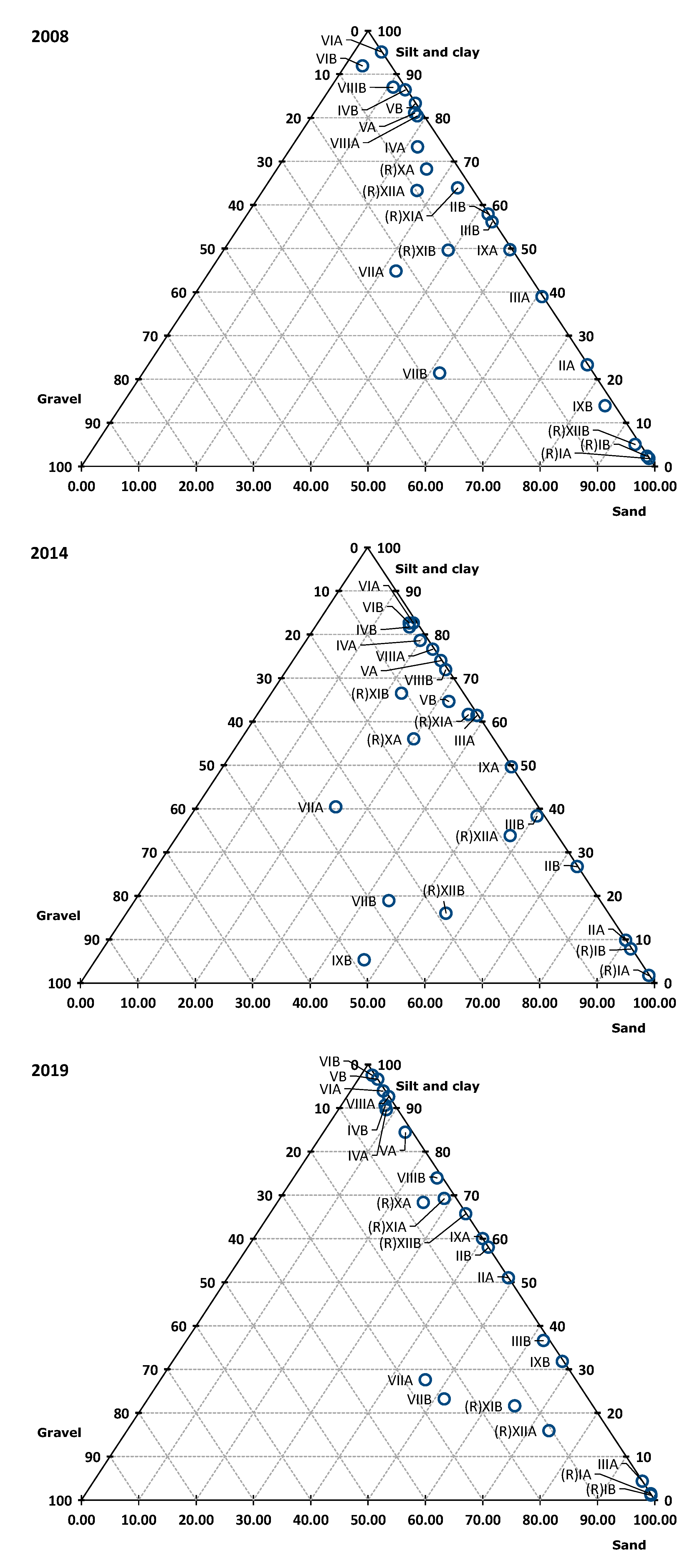
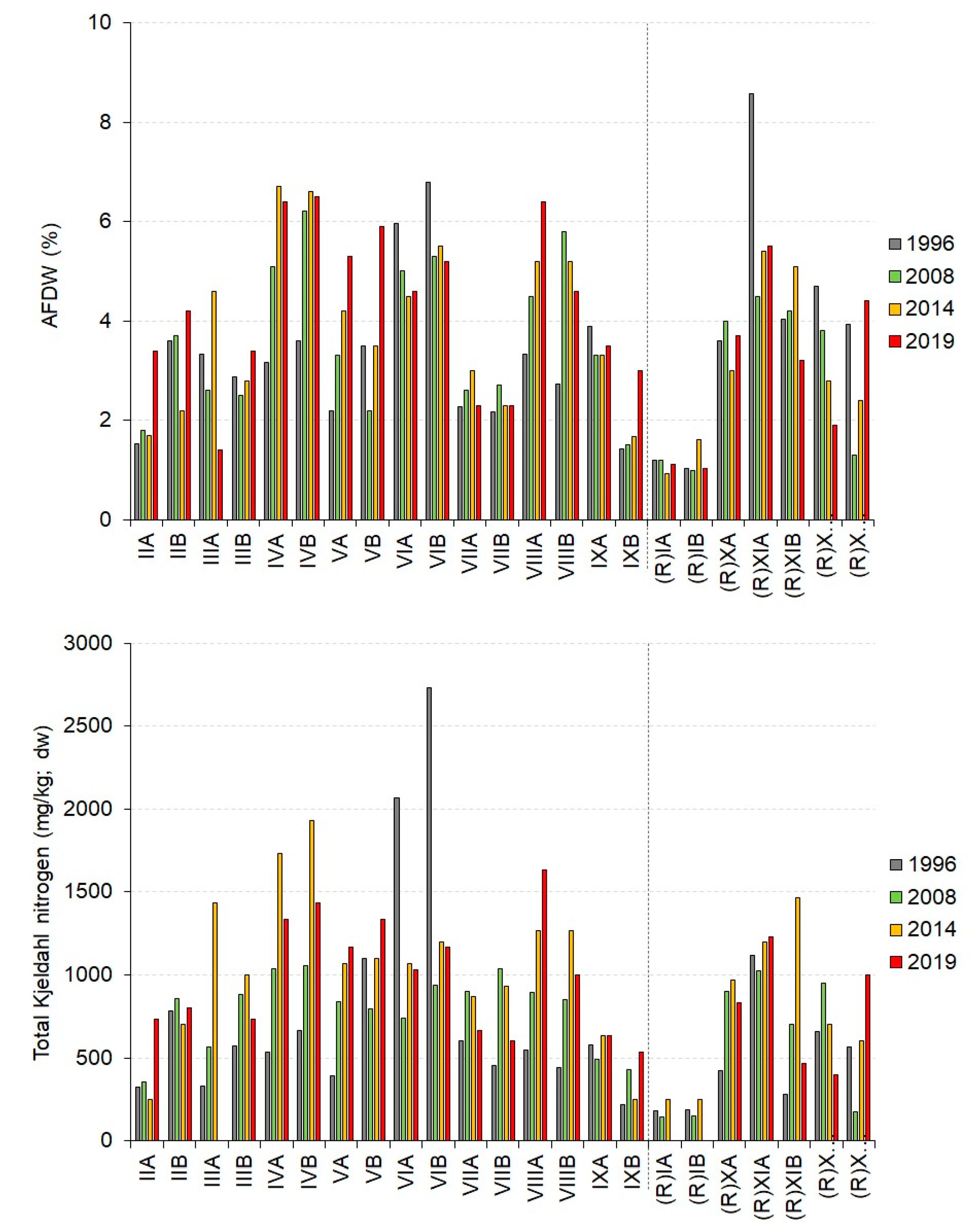
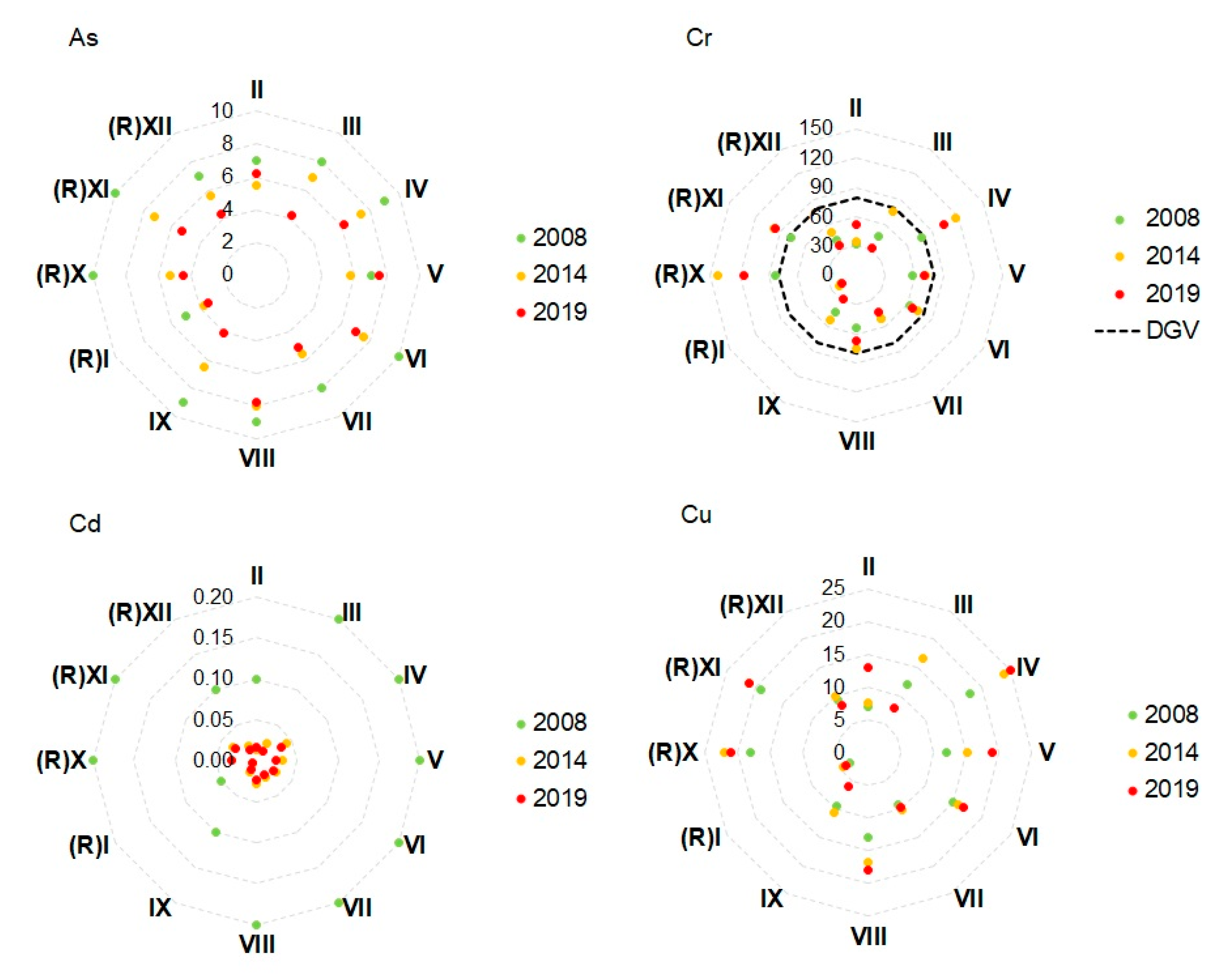
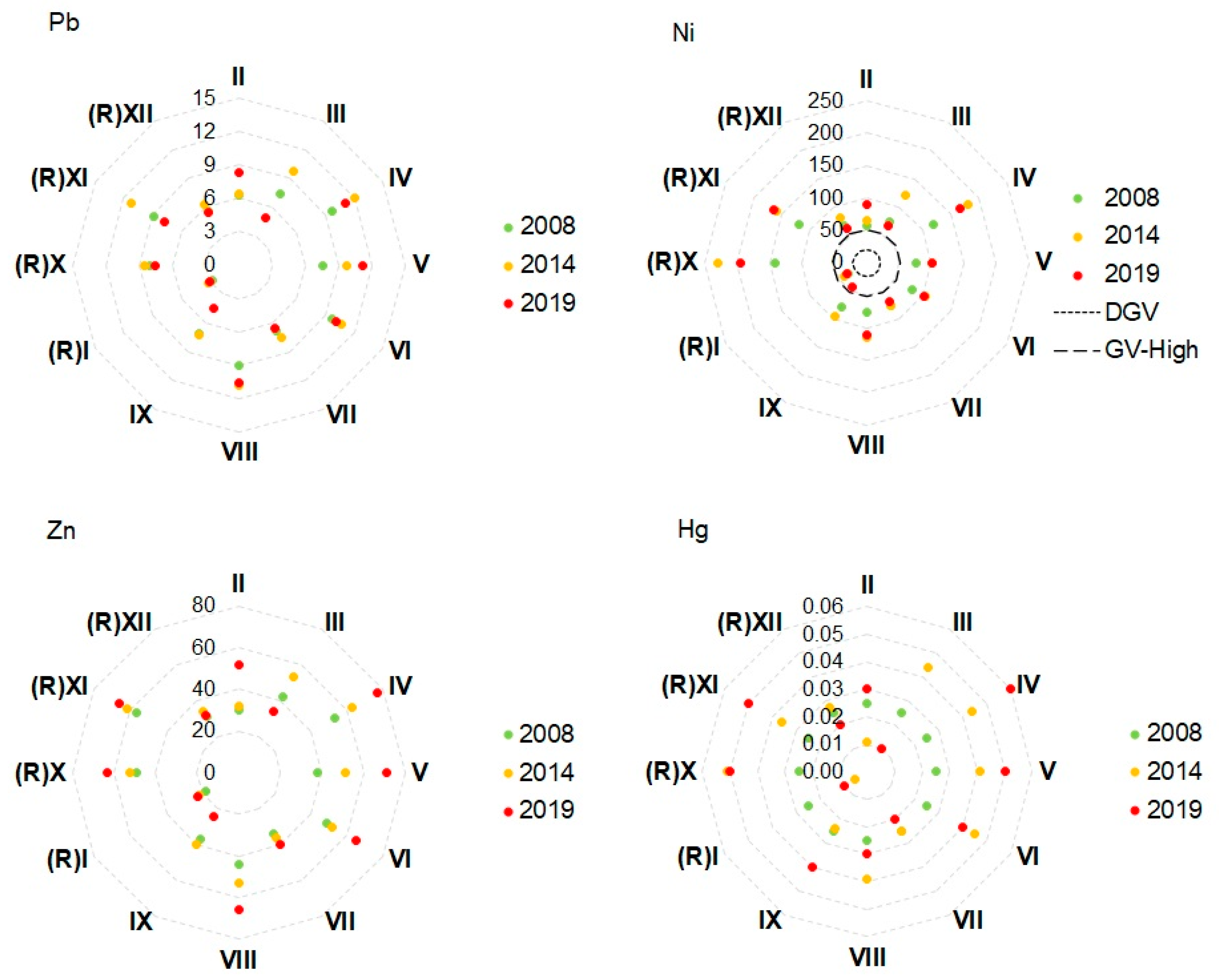
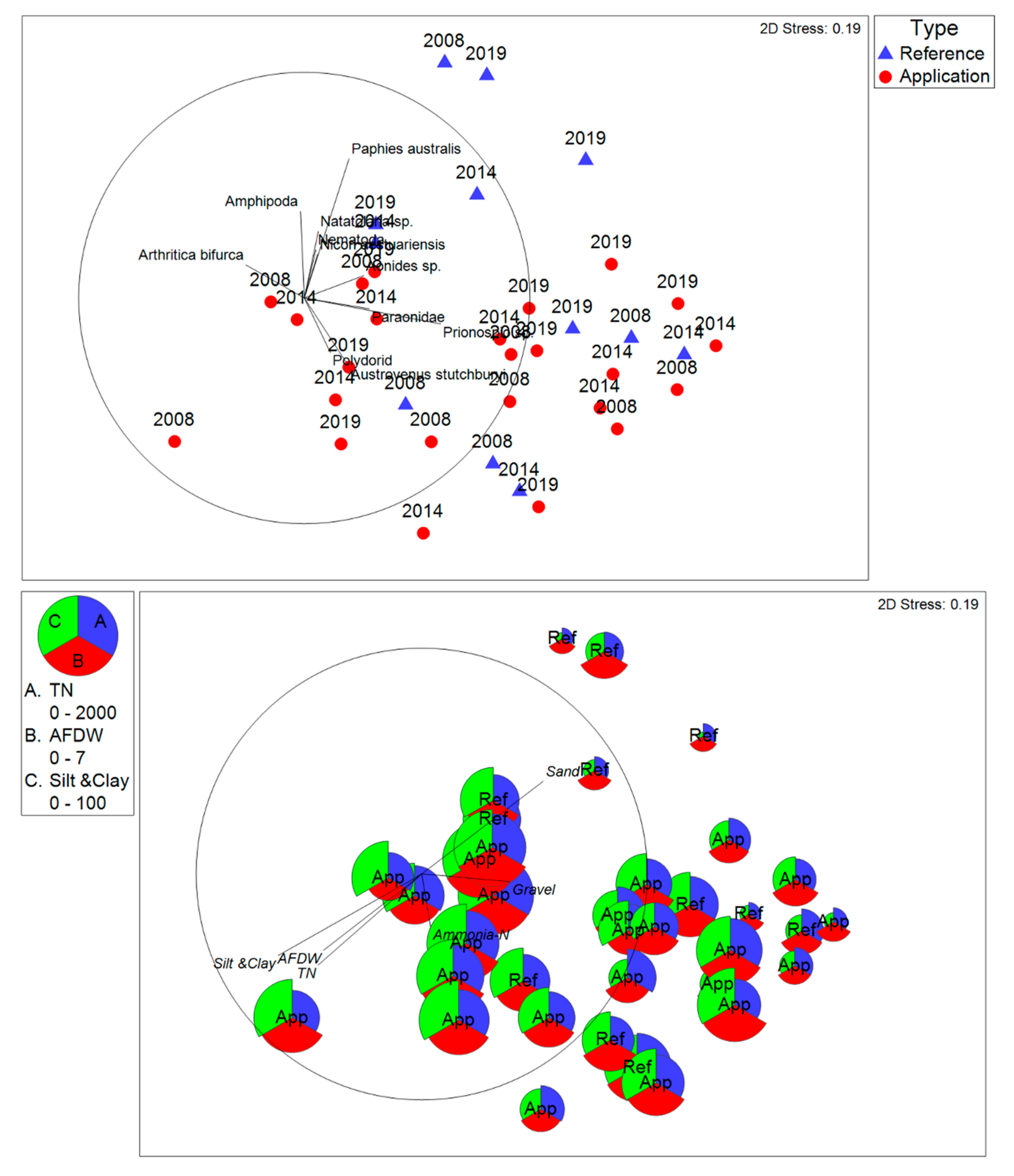
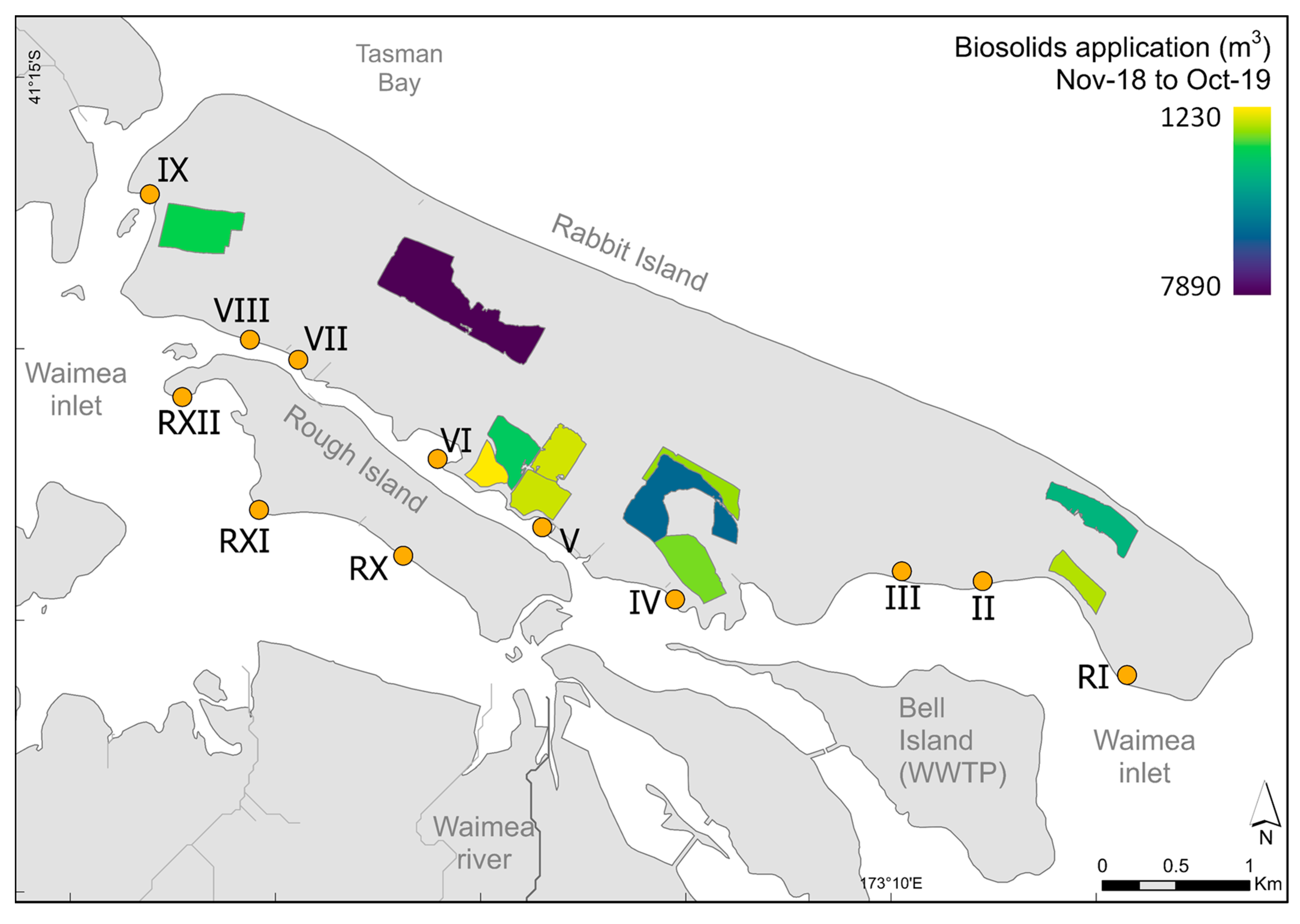
| Transect Number | ||||||||||||||
|---|---|---|---|---|---|---|---|---|---|---|---|---|---|---|
| Application | Reference | |||||||||||||
| Survey Year | Site | II | III | IV | V | VI | VII | VIII | IX | I | X | XI | XII | |
| Approximate transect length (m) | 160 | 26 | 24 | 50 | 75 | 25 | 24 | 60 | 40 | 24 | 70 | 60 | ||
| Average density of crab holes 1 | 1996 | A | 115 | 25 | 21 | 19 | 2 | 15 | 15 | 37 | - | 5 | 6 | 23 |
| B | 11 | 17 | 15 | 24 | 16 | 13 | 8 | 8 | - | n/s | 5 | 4 | ||
| Macroalgal % cover | B | 0 | 0 | 0 | 50 | 90 | 60 | <5 | <5 | 0 | 0 | 0 | <5 | |
| Average density of crab holes 1 | 2008 | A | 21 | 39 | 23 | 51 | 43 | 5 | 4 | 32 | 0.2 | 3 | 6 | 19 |
| B | 20 | 20 | 23 | 17 | 18 | 5 | 43 | 0.6 | 1 | 6 | 1 | |||
| Macroalgal % cover | B | 0 | 0 | 0 | 0 | 0 | <5 | 1 | 6 | 0 | 0 | <5 | 9 | |
| Average density of crab holes 1 | 2014 | A | 12 | 67 | 7 | 31 | 46 | 10 | 76 | 23 | 0.2 | 7 | 2 | 4 |
| B | 25 | 17 | 13 | 21 | 46 | 2 | 63 | 2 | 1 | n/s | 19 | 0 | ||
| Macroalgal % cover | B | 0 | 0 | 0 | 0 | 0 | 36 | 0 | 13 | 0 | n/s | <4 | 19 | |
| Average density of crab holes 1 | 2019 | A | 50 | 12 | 20 | 9 | 20 | 6 | 34 | 25 | 0 | 5 | 3 | 0.8 |
| B | 52 | 48 | 4 | 7 | 13 | 1 | 19 | 0.3 | 0 | 0 | 2 | 0.08 | ||
| Macroalgal % cover | B | 0 | 0 | 0 | 80 | 87 | 75 | 0 | 35 | 0 | 33 | 34 | 32 | |
| 2008 | 2014 | 2019 | ||||
|---|---|---|---|---|---|---|
| Transect | Enterococci | E. coli | Enterococci | E. coli | Enterococci | E. coli |
| Application | ||||||
| II | 110 | 50 | 2400 | 790 | 40 | <30 |
| III | <20 | 20 | 700 | 330 | <30 | <30 |
| IV | 170 | 20 | 120 | 170 | ns | ns |
| V | 490 | 330 | >16,000 | 2200 | ns | ns |
| VI | 170 | <20 | 490 | 790 | ns | ns |
| VII | 20 | <20 | 230 | 40 | <30 | <30 |
| VIII | 130 | 20 | 460 | 50 | ns | ns |
| IX | 20 | <20 | 1300 | 170 | <30 | <30 |
| Reference | ||||||
| I | 20 | 80 | 790 | 790 | 40 | 92 |
| X | 140 | 490 | 3500 | 3500 | 90 | 2100 |
| XI | 20 | 20 | 270 | 1300 | 70 | <30 |
| XII | 50 | 700 | 50 | 80 | <30 | <30 |
| Taxonomic Group | Application (II, III, IV, V, VI, VII, VIII, IX) | Reference (I, X, XI, XII) | ||
|---|---|---|---|---|
| Mean | SD | Mean | SD | |
| 2008 survey | ||||
| Species richness | 7.9 | 4.1 | 8.17 | 4.12 |
| Abundance | 65.3 | 62.8 | 46.25 | 42.90 |
| Evenness | 0.7 | 0.1 | 0.76 | 0.13 |
| Diversity | 1.3 | 0.4 | 1.52 | 0.38 |
| 2014 survey | ||||
| Species richness | 12.1 | 6.1 | 13.33 | 5.1 |
| Abundance | 123.8 | 103.2 | 155.1 | 166.1 |
| Evenness | 0.7 | 0.1 | 0.62 | 0.14 |
| Diversity | 1.7 | 0.4 | 1.57 | 0.4 |
| 2019 survey | ||||
| Species richness | 13.2 | 7.2 | 10.83 | 4.88 |
| Abundance | 101.9 | 7.4 | 107.6 | 56.1 |
| Evenness | 0.7 | 0.1 | 0.64 | 0.11 |
| Diversity | 1.7 | 0.5 | 1.48 | 0.43 |
| Survey | Taxon | Average Abundance (Individuals/m2) | |||||
|---|---|---|---|---|---|---|---|
| Reference (I, X, XI, XII) | Application (II, III, IV, V, VI, VII, VIII, IX) | Av. Diss | Diss/SD | % Contrib | % Cum | ||
| 2008 a | Prionospio sp. | 1.99 | 3.03 | 9.19 | 1.28 | 12.09 | 12.09 |
| Arthritica bifurca | 0.6 | 1.73 | 6.32 | 0.87 | 8.32 | 20.41 | |
| Heteromastus filiformis | 0.96 | 2.17 | 6.02 | 1.2 | 7.93 | 28.34 | |
| Austrovenus stutchburyi | 1.89 | 1.74 | 5.86 | 1.03 | 7.71 | 36.05 | |
| Paphies australis | 1.31 | 0.18 | 5.08 | 0.56 | 6.69 | 42.74 | |
| Amphipoda | 1.15 | 0.72 | 4.46 | 0.86 | 5.87 | 48.61 | |
| Paraonidae | 1.25 | 0.78 | 4.01 | 1.01 | 5.28 | 53.89 | |
| Nicon aestuariensis | 0.77 | 0.9 | 3.58 | 0.85 | 4.71 | 58.6 | |
| Hemiplax hirtipes | 0.7 | 0.82 | 3.19 | 0.95 | 4.2 | 62.8 | |
| Austrohelice crassa | 0 | 0.5 | 2.57 | 0.59 | 3.38 | 66.18 | |
| Linucula hartvigiana | 0.61 | 0.64 | 2.49 | 0.61 | 3.27 | 69.45 | |
| Cirratulidae | 0.81 | 0.2 | 2.15 | 0.64 | 2.83 | 72.28 | |
| 2014 b | Prionospio sp. | 3.22 | 3.78 | 7.01 | 1.35 | 9.23 | 9.23 |
| Aonides sp. | 3.8 | 1.31 | 5.52 | 0.8 | 7.26 | 16.49 | |
| Arthritica bifurca | 1.3 | 2.3 | 5.02 | 0.99 | 6.61 | 23.1 | |
| Paphies australis | 1.98 | 0 | 4.55 | 0.57 | 5.99 | 29.09 | |
| Austrovenus stutchburyi | 2.66 | 2.06 | 4.29 | 1.25 | 5.65 | 34.73 | |
| Amphipoda | 2.25 | 1.03 | 4.14 | 0.82 | 5.45 | 40.18 | |
| Paraonidae | 1.01 | 2.38 | 4.03 | 0.77 | 5.3 | 45.48 | |
| Heteromastus filiformis | 0.94 | 1.88 | 3.37 | 0.93 | 4.43 | 49.91 | |
| Polydorid | 1.14 | 1.06 | 3.03 | 0.94 | 3.99 | 53.9 | |
| Amphibola crenata | 0.54 | 0.85 | 2.44 | 0.78 | 3.21 | 57.11 | |
| Nereididae (juvenile) | 0.99 | 0.92 | 1.94 | 1.08 | 2.55 | 59.66 | |
| Austrominius modestus | 0.25 | 0.72 | 1.83 | 0.52 | 2.41 | 62.07 | |
| Oligochaeta | 0.64 | 0.64 | 1.65 | 0.9 | 2.18 | 64.24 | |
| Notoacmea sp. | 0.67 | 0.74 | 1.64 | 0.58 | 2.16 | 66.41 | |
| Austrohelice crassa | 0.53 | 0.53 | 1.61 | 0.85 | 2.12 | 68.53 | |
| Hemiplax hirtipes | 0.62 | 0.87 | 1.57 | 1.06 | 2.06 | 70.59 | |
| 2019 c | Paphies australis | 3.34 | 0.46 | 7.38 | 0.87 | 9.36 | 9.36 |
| Prionospio sp. | 2.43 | 2.31 | 5.68 | 1 | 7.2 | 16.56 | |
| Amphipoda | 2.92 | 1.59 | 5.21 | 0.95 | 6.6 | 23.17 | |
| Oligochaeta | 2.35 | 1.8 | 4.56 | 1.16 | 5.79 | 28.95 | |
| Polydorid | 0.14 | 2.01 | 4.31 | 1 | 5.47 | 34.42 | |
| Paraonidae | 0.75 | 2.32 | 4.2 | 0.77 | 5.33 | 39.75 | |
| Arthritica bifurca | 1.16 | 1.16 | 3.57 | 0.78 | 4.53 | 44.27 | |
| Amphibola crenata | 0.52 | 1.23 | 3.29 | 0.83 | 4.17 | 48.45 | |
| Aonides sp. | 0.2 | 2.07 | 3.29 | 0.61 | 4.17 | 52.61 | |
| Exosphaeroma sp. | 1.56 | 0.3 | 3.23 | 0.84 | 4.1 | 56.71 | |
| Nicon aestuariensis | 1.58 | 0.45 | 2.96 | 1.13 | 3.75 | 60.46 | |
| Heteromastus filiformis | 0.8 | 1.02 | 2.34 | 0.93 | 2.96 | 63.42 | |
| Hemiplax hirtipes | 0.62 | 1.4 | 2.24 | 1.27 | 2.84 | 66.26 | |
| Nemertea | 0.58 | 1.17 | 1.89 | 1.2 | 2.4 | 68.66 | |
| Natatolana sp. | 0.79 | 0.06 | 1.86 | 0.87 | 2.36 | 71.02 | |
| Survey | Taxon | Application (II, III, IV, V, VI, VII, VIII, IX) | Taxon | Reference (I, X, XI, XII) | ||
|---|---|---|---|---|---|---|
| Mean | SD | Mean | SD | |||
| 2008 | Prionospio sp. | 23.5 | 42.9 | Prionospio sp. | 10.6 | 21.2 |
| Heteromastus filiformis | 9.0 | 11.2 | Paphies australis | 6.4 | 13.1 | |
| Arthritica bifurca | 7.5 | 12.9 | Austrovenus stutchburyi | 5.3 | 5.8 | |
| Austrovenus stutchburyi | 5.3 | 7.5 | Paraonidae | 4.2 | 10.5 | |
| Linucula hartvigiana | 3.4 | 9.7 | Heteromastus filiformis | 3.0 | 6.6 | |
| Oligochaeta | 3.3 | 9.2 | Amphipoda | 2.8 | 3.6 | |
| Paraonidae | 2.3 | 7.3 | Cirratulidae | 2.8 | 6.2 | |
| Amphipoda | 1.8 | 3.7 | Linucula hartvigiana | 1.6 | 3.3 | |
| Macomona liliana | 1.7 | 5.1 | Nicon aestuariensis | 1.5 | 2.2 | |
| Nicon aestuariensis | 1.4 | 1.6 | Arthritica bifurca | 1.1 | 2.3 | |
| 2014 | Anthozoa | 26.7 | 0.5 | Anthozoa | 50.1 | 0.0 |
| Nemertea | 23.9 | 1.0 | Nemertea | 34.8 | 0.8 | |
| Nematoda | 13.1 | 0.0 | Nematoda | 13.8 | 0.0 | |
| Sipuncula | 9.4 | 0.3 | Sipuncula | 11.9 | 0.0 | |
| Chiton glaucus | 9.0 | 0.4 | Chiton glaucus | 9.8 | 0.3 | |
| Ischnochiton maorianus | 7.4 | 0.0 | Ischnochiton maorianus | 5.0 | 0.0 | |
| Gastropoda (micro snails) | 3.6 | 0.2 | Gastropoda (micro snails) | 3.6 | 0.3 | |
| Pyramidellidae | 3.5 | 0.0 | Pyramidellidae | 3.3 | 0.0 | |
| Amphibola crenata | 3.0 | 7.4 | Amphibola crenata | 2.8 | 2.5 | |
| Caecum digitulum | 3.0 | 0.2 | Caecum digitulum | 1.8 | 0.0 | |
| 2019 | Anthozoa | 18.0 | 0.0 | Anthozoa | 24.8 | 0.0 |
| Nemertea | 16.4 | 2.5 | Nemertea | 20.7 | 1.1 | |
| Nematoda | 11.9 | 0.0 | Nematoda | 15.8 | 4.7 | |
| Sipuncula | 7.5 | 0.4 | Sipuncula | 11.5 | 0.0 | |
| Chiton glaucus | 6.7 | 0.4 | Chiton glaucus | 5.6 | 0.0 | |
| Ischnochiton maorianus | 5.2 | 0.2 | Ischnochiton maorianus | 4.3 | 0.0 | |
| Gastropoda (micro snails) | 4.3 | 0.0 | Gastropoda (micro snails) | 3.7 | 0.0 | |
| Pyramidellidae | 3.9 | 0.4 | Pyramidellidae | 2.6 | 0.0 | |
| Amphibola crenata | 2.5 | 5.8 | Amphibola crenata | 2.3 | 4.3 | |
| Caecum digitulum | 2.5 | 0.5 | Caecum digitulum | 2.3 | 0.0 | |
Disclaimer/Publisher’s Note: The statements, opinions and data contained in all publications are solely those of the individual author(s) and contributor(s) and not of MDPI and/or the editor(s). MDPI and/or the editor(s) disclaim responsibility for any injury to people or property resulting from any ideas, methods, instructions or products referred to in the content. |
© 2023 by the authors. Licensee MDPI, Basel, Switzerland. This article is an open access article distributed under the terms and conditions of the Creative Commons Attribution (CC BY) license (https://creativecommons.org/licenses/by/4.0/).
Share and Cite
Campos, C.J.A.; Berthelsen, A.; MacLean, F.; Floerl, L.; Morrisey, D.; Gillespie, P.; Clarke, N. Monitoring Intertidal Habitats for Effects from Biosolids Applications onto an Adjacent Forestry Plantation. Sustainability 2023, 15, 12279. https://doi.org/10.3390/su151612279
Campos CJA, Berthelsen A, MacLean F, Floerl L, Morrisey D, Gillespie P, Clarke N. Monitoring Intertidal Habitats for Effects from Biosolids Applications onto an Adjacent Forestry Plantation. Sustainability. 2023; 15(16):12279. https://doi.org/10.3390/su151612279
Chicago/Turabian StyleCampos, Carlos J. A., Anna Berthelsen, Fiona MacLean, Lisa Floerl, Don Morrisey, Paul Gillespie, and Nathan Clarke. 2023. "Monitoring Intertidal Habitats for Effects from Biosolids Applications onto an Adjacent Forestry Plantation" Sustainability 15, no. 16: 12279. https://doi.org/10.3390/su151612279
APA StyleCampos, C. J. A., Berthelsen, A., MacLean, F., Floerl, L., Morrisey, D., Gillespie, P., & Clarke, N. (2023). Monitoring Intertidal Habitats for Effects from Biosolids Applications onto an Adjacent Forestry Plantation. Sustainability, 15(16), 12279. https://doi.org/10.3390/su151612279









